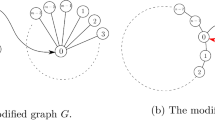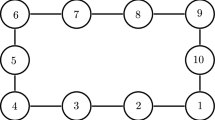Abstract
Multiple mobile agents with double integrator dynamics, following a leader to achieve a flocking motion formation, are studied in this paper. A class of local control laws for a group of mobile agents is proposed. From a theoretical proof, the following conclusions are reached: (i) agents globally align their velocity vectors with a leader, (ii) they converge their velocities to the leaders velocity, (iii) collisions among interconnected agents are avoided, and (iv) agent’s artificial potential functions are minimized. We model the interaction and/or communication relationship between agents by algebraic graph theory. Stability analysis is achieved by using classical Lyapunov theory in a fixed network topology, and differential inclusions and nonsmooth analysis in a switching network topology respectively. Simulation examples are provided.
Similar content being viewed by others
References
D. J. Low. Following the crowd. Nature, vol. 407, no. 6803, pp. 465–466, 2000.
T. Vicsek. A question of scale. Nature, vol. 411, no. 6836, pp. 421, 2001.
D. Grunbaum, A. Okubo. Modeling social animal aggregations. Frontiers in Theoretical Biology, Lecture Notes in Biomathematics, Springer-Verlag, vol. 100, pp. 296–325, 1994.
G. Flierl, D. Grunbaum, S. Levin, D. Olson. From individuals to aggregations: the interplay between behavior and physics. Journal of Theoretical Biology, vol. 196, no. 2, pp. 397–454, 1999.
C. Reynolds. Flocks, birds, and schools: a distributed behavioral model. Computer Graphics, vol. 21, no. 1, pp. 25–34, 1987.
D. Terzopoulos. Artificial life for computer graphics. Communications of the ACM, vol. 42, no. 8, pp. 32–42, 1999.
T. Vicsek, A. Czirok, E. B. Jacob, I. Cohen, O. Schochet. Novel type of phase transitions in a system of self-driven particles. Physical Review Letters, vol. 75, no. 2, pp. 1226–1229, 1995.
J. Toner, Y. Tu. Flocks, herds, and schools: A quantitative theory of flocking. Physical Review E., vol. 58, no. 6, pp. 4828–4858, 1998.
H. Levine, W. J. Rappel. Self organization in systems of self-propelled particles. Physical Review E, vol. 63, no. 2, pp. 208–211, 2001.
N. Leonard, E. Friorelli. Virtual leaders, artificial potentials and coordinated control of groups. IEEE Conference on Decision and Control, Orlando, Florida USA, pp. 2968–2973, 2001.
R. Olfati, R. M. Murray. Distributed structural stabilization and tracking for formations of dynamic multi-agents. IEEE Conference on Decision and Control, Las Vegas, NV, pp. 209–215, 2002.
H. R. John, W. Hongyang. Social potential fields: A distributed behavioral control for autonomous robots. Robotics and Autonomous Systems, vol. 27, no. 3, pp. 171–194, 1999.
Y. Liu, K. M. Passino, M. M. Polycarpou. Stability analysis of m-dimensional asynchronous swarms with a fixed communication topology. IEEE Transactions on Automatic Control, vol. 48, no. 1, pp. 76–95, 2003.
V. Gazi, K. M. Passino. Stability analysis of swarms. IEEE Transactions on Automatic Control, vol. 48, no. 4, pp. 692–696, 2003.
A. Jadbabaie, J. Lin, A. S. Morse. Coordination of groups of mobile autonomous agents using nearest neighbor rules. IEEE Transactions on Automatic Control, vol. 48, no. 6, pp. 988–1001, 2002.
J. P. Desai, J. P. Ostrowski, V. Kumar. Modeling and control of formations of nonholonomic mobile robots. IEEE Transactions on Robotics and Automation, vol. 17, no. 6, pp. 905–908, 2001.
Z. Lin, M. Broucke, B. Francis. Local control strategies for groups of mobile autonomous agents. IEEE Transactions on Automatic Control, vol. 49, no. 4, pp. 622–629, 2004.
H. G. Tanner, A. Jadbabaie, G. J. Pappas. Stable Flocking of Mobile Agents, Part I: Fixed Topology. 42nd IEEE Conference on Decision and Control, Maui, Hawaii USA, pp. 2010–2015, 2003.
H. G. Tanner, A. Jadbabaie, G. J. Pappas. Stable Flocking of Mobile Agents, Part II: Dynamic Topology. 42nd IEEE Conference on Decision and Control, Maui, Hawaii USA, pp. 2016–2021, 2003.
J. Toner, Y. Tu. Long range order in a two dimensional xy model: How birds fly together. Physical Review Letters, vol. 75, no. 6, pp. 4326–4329, 1995.
J. Toner, Y. Tu. Flocks, herds, and schools: A quantitative theory of flocking. Physical Review E, vol. 58, no. 6, pp. 4828–4858, 1998.
A. F. Filippov. Differential equations with discontinuous right-hand side. Translations of the American Mathematical Society, vol. 42, no. 2, pp. 199–231, 1964.
F. H. Clarke. Optimization and Nonsmooth Analysis, Classics in applied mathematics, 5, SIAM, Philadelphia, 1990.
F. H. Clarke, Y. S. Ledyaev, R. J. Stern, P. R. Wolenski. Nonsmooth Analysis and Control Theory, Graduate Texts in Mathematics, 178, Springer, New York, 1998.
D. Shevitz, B. Paden. Lyapunov stability theory of nonsmooth systems. IEEE Transactions on Automatic Control, vol. 39, no. 9, pp. 1910–1914, 1994.
B. Paden, S. Sastry. A calculus for computing filipov’s differential inclusion with application to the variable structure control of robot manipulators. IEEE Transactions on Circuits and Systems, vol. 34, no. 1, pp. 73–82, 1987.
Author information
Authors and Affiliations
Corresponding author
Additional information
This work was supported in part by the NSFC (No.60274020), and the NSFC International Collaborative Project (No.60340420431).
Hui Yu was born in Yichang, Hubei, P. R. China, in 1967. He received his BSc degree in Mathematics Education from Central China Normal University, Wuhan, P. R. China, a M. S. degree in System analysis and integration from East China Normal University, Shanghai, P. R. China, in 1991 and 1999, respectively. From July 1999 to September 2004, he was a lecturer at the Department of Mathematics, China Three Gorges University, Yichang, Hubei, P. R. China. Since September 2004, he has been a doctoral candidate at the Department of Control Science & Engineering, Huazhong University of Science & Technology, Wuhan, P. R. China. His research interests are in the distributed coordination of mobile autonomous multiagents, as well as the application of mobile sensor networks and robotics.
Yong-Ji Wang was born in Ji’an, Jiangxi, P.R. China, in 1955. He received his BSc degree in Electrical Engineering from Shanghai Railway University, Shanghai, P.R. China, an M.S. degree and a Ph.D degree in automation from Huazhong University of Science and Technology, Wuhan, P.R. China, in 1982, 1984 and 1990, respectively. Since 1984, he has been at Huazhong University of Science and Technology, Wuhan, P.R. China, where he is currently a Professor of Electrical Engineering. His main interest is in intelligent control, neural network, predictive, adaptive control, and most recently, coordination and control of large groupings of mobile autonomous agents.
Dr. Wang is a member of the IEEE, USA, a standing member of the council of the Electric Automation Committee of the Chinese Automation Society, and a member of the council of the Intelligent Robot Committee of the Chinese Artificial Intelligence Society. He is an area editor (Asia and Pacific) of the Int. J. of Simulation Identification and Control.
Rights and permissions
About this article
Cite this article
Yu, H., Wang, YJ. Stable flocking motion of mobile agents following a leader in fixed and switching networks. Int J Automat Comput 3, 8–16 (2006). https://doi.org/10.1007/s11633-006-0008-x
Received:
Revised:
Issue Date:
DOI: https://doi.org/10.1007/s11633-006-0008-x




